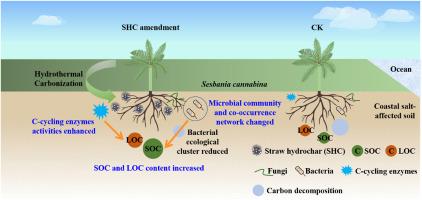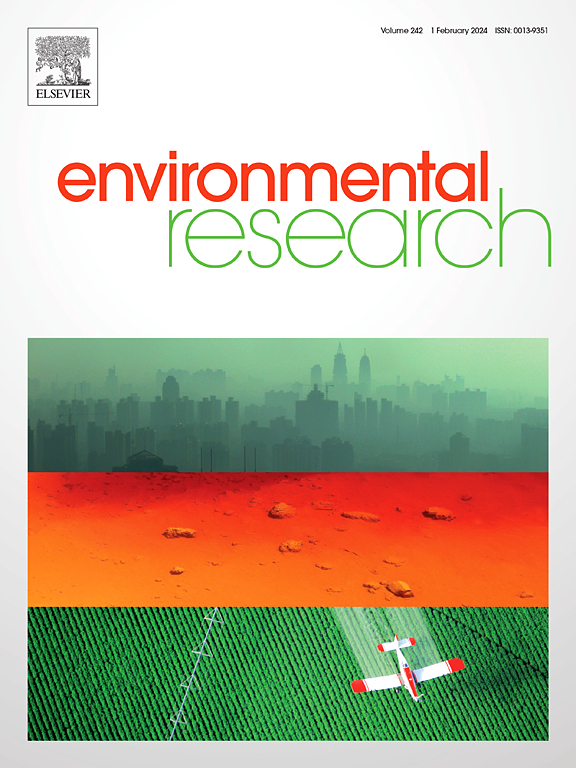中国黄河三角洲用水炭改良的近岸盐碱地土壤中微生物群落和网络生态群落受土壤有机碳驱动的变异。
IF 7.7
2区 环境科学与生态学
Q1 ENVIRONMENTAL SCIENCES
引用次数: 0
摘要
炭材料(如水炭)可以提高碳固存、改善土壤质量并调节土壤微生物群落,从而恢复土壤健康。然而,人们对近岸盐碱土壤中土壤有机碳(SOC)含量以及微生物群落和共生网络对水炭添加剂的响应知之甚少。在此,我们利用盆栽实验说明了大叶大麻(一种盐生植物)秸秆衍生水碳(SHC)改良剂对 SOC 和可溶性有机碳(LOC)组分的影响,以及 SOC 含量变化、土壤碳循环酶活性和微生物群落之间的潜在关联。SHC 有效提高了 SOC 和 LOC 的含量,尤其是颗粒有机碳(POC),并刺激了 C 循环酶的活性。此外,SHC 引发了微生物群落组成和共生网络的变化,导致放线菌群及其相应生态群的相对丰度下降,这可能有利于 SOC 的积累。原核生物类群的功能注释(FAPROTAX)分析也揭示了与碳降解相关的微生物生态功能的下降。这些发现深入揭示了水炭诱导的 SOC 增效,并提出了一种有效的方法来提高沿海盐渍土壤的固碳能力并改善土壤健康。本文章由计算机程序翻译,如有差异,请以英文原文为准。

Variation in microbial communities and network ecological clusters driven by soil organic carbon in an inshore saline soil amended with hydrochar in Yellow River Delta, China
Char materials (e.g., hydrochar) can enhance carbon sequestration, improve soil quality and modulate soil microbial communities to recuperate soil health. However, little is known about the soil organic carbon (SOC) content, as well as the microbial communities and co-occurrence networks in response to hydrochar amendment in an inshore saline soil. Here, the effect of Sesbania cannabina (a halophyte) straw derived hydrochar (SHC) amendment on SOC and labile organic carbon (LOC) fractions and the potential associations among SOC content change, soil C-cycling enzyme activities and microbial communities were illustrated using a pot experiment. SHC effectively improved the contents of SOC and LOC, particularly particulate organic carbon (POC), and stimulated the activities of C-cycling enzymes. Furthermore, SHC induced shift in microbial community compositions and co-occurrence networks, result in decrease in relative abundance of Actinobacteriota and its corresponding ecological cluster, which may favor SOC accumulation. Functional annotation of prokaryotic taxa (FAPROTAX) analysis also revealed a decrease in microbial ecological function related to carbon degradation. These findings provided a deeper insight about the hydrochar-induced SOC enhancement and suggested an efficient approach to improve C sequestration and improve soil health in the coastal salt-affected soil.
求助全文
通过发布文献求助,成功后即可免费获取论文全文。
去求助
来源期刊

Environmental Research
环境科学-公共卫生、环境卫生与职业卫生
CiteScore
12.60
自引率
8.40%
发文量
2480
审稿时长
4.7 months
期刊介绍:
The Environmental Research journal presents a broad range of interdisciplinary research, focused on addressing worldwide environmental concerns and featuring innovative findings. Our publication strives to explore relevant anthropogenic issues across various environmental sectors, showcasing practical applications in real-life settings.
 求助内容:
求助内容: 应助结果提醒方式:
应助结果提醒方式:


